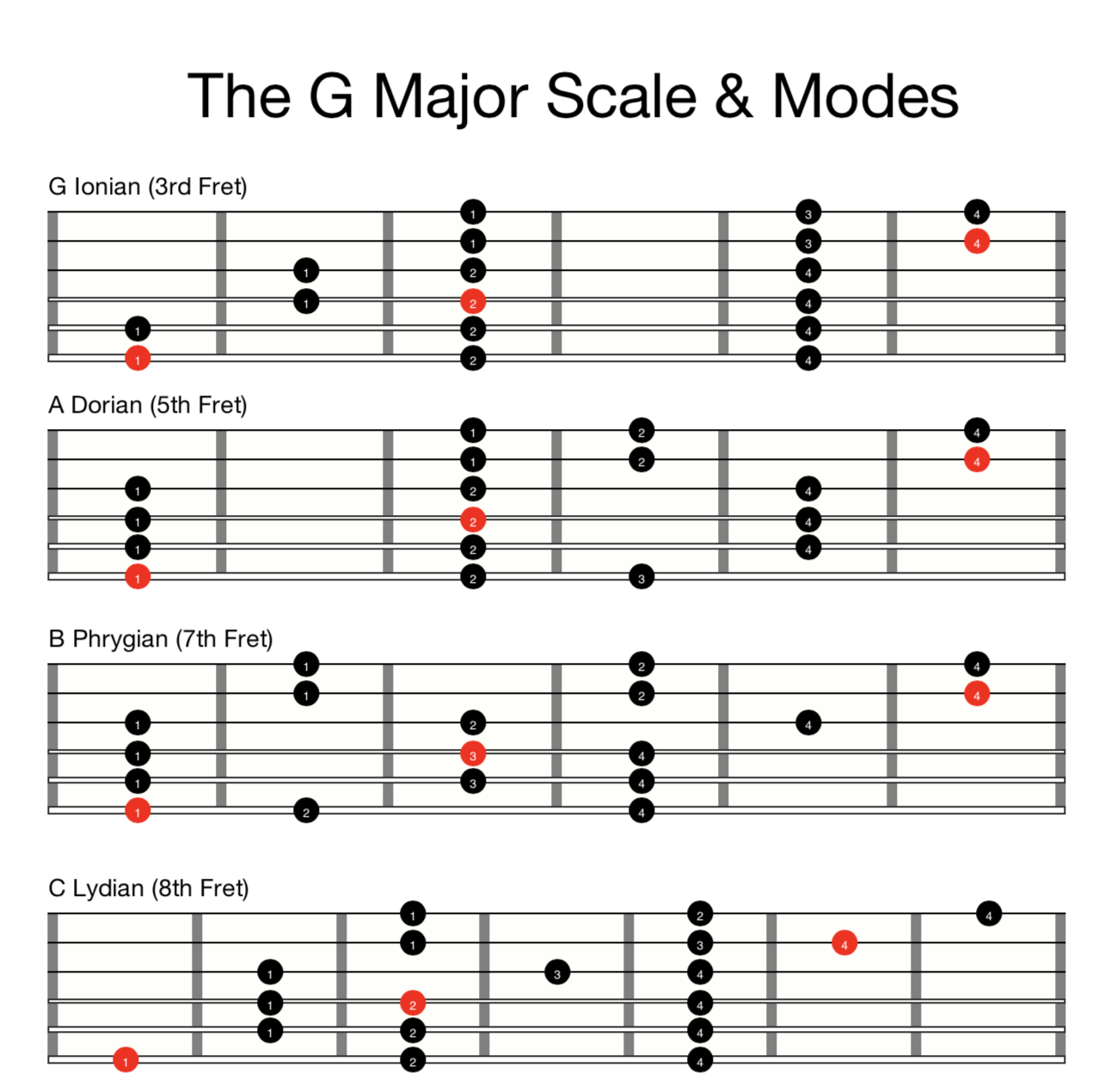You may have heard me say that there’s really only 3 scales you need to master on the guitar.
That being said, every now and again you’ll hit this limit. You’ll feel like your soloing or melody lines just aren’t interesting any more.
You’re getting a bit stale.
What’s the solution? Not exactly new scales….but new ways to play those scales!
If you’re after the ultimate scale workout, the holy grail of versatile, entire fretboard-spanning shapes to practice, then this is the one for you.
Root notes are marked in red, and are the modal root notes.
That first shape should look familiar - it’s our 3 note per string major scale, with the root note on the bottom string.
In this example, we’re going to focus on one key (G Major/E Natural Minor) to keep things easy. Once you have them all memorised, you can jump around to different keys.
The Techniques to Use
Because there’re three notes on each string, the most efficient picking style is economy picking.
In other words, we’re going to pick Down-Up-Down on each string, then on the way back, we’re going to pick Up-Down-Up.
Always start from the bottom string first, working your way to the top and then back again (in these diagrams, you can see the thicker string is at the bottom, so in effect, you read it from bottom left to top right for each scale shape).
Once you can get the shapes ok, mix it up - try different rhythms, changing up the order or just start improvising if you feel confident.
If you’re more of a fingerstyle player, use your a, m and i fingers (your ring, middle and index fingers respectively) in the same order on each string (for example a-m-i or i-m-a).
Finally, play legato using hammer-ons, pull-offs or tapping if you’d like.
What’s with the weird scale names?
Now, this music theory sounds complicated, but it’s really not at all. Trust me - there’s no tricks to it, it’s all just a matter of perspective.
In G Major, we have the notes G - A - B - C - D - E - F#. For those who have heard about relative minors, the relative minor of G Major is E Minor, which has the notes E - F# - G - A - B - C - D.
In other words, exactly the same notes in a different order.
What you may not know is that there are 5 other relative scales that have the same notes as G Major, which we call Modes. G Major, in modal terms, is called G Ionian (same scale, different name). E Natural Minor is called E Aeolian (again, same scale, different name.
If I start from A and use the same notes (A - B - C - D - E - F# - G) I get what’s called an A Dorian scale.
If I start from B and use the same notes (B - C - D - E - F# - G - A) I get what’s called a B Phrygian scale.
Same thing applies for C Lydian, D Mixolydian, and F# Locrian.
In practical terms, it doesn’t really matter which scale you play - what matters is what chords you’re playing over. So, if you were to play an A Dorian Scale over a song in the key of G Major, it’s still going to sound like G Major - it’s the same notes after all.
Where modes get interesting is when instead of playing an A Natural Minor scale, you instead choose to use an A Dorian Scale, giving a different flavour to the song. If you’d like some deeper insights on this, check out this article on which scales to use over which chords.
But, if you’re not so interested in the modal side of things just yet, don’t worry - you can think of every single one of these shapes as a different way to play G Major as that is also accurate.
How to use this scale
By connecting up each of these 7 shapes, you have covered the ENTIRE fretboard (remember it all just repeats after the 12th fret). Forget the old box shapes - this is freedom to see G Major on the whole guitar!
In practice, you’ll probably want to stick to one or two of the shapes initially until you feel comfortable with it as a soloing tool. From there you can slowly add the other shapes in, then you’ll jump between them all mid-solo.
Eventually, you won’t even necessarily need the shapes, as you’ll just know where all the correct notes lie.
Longer term, you’re going to want to use these shapes for other keys, so I’d recommend jumping to C Major next as that’s also a very versatile key on the guitar.
Now, for the ultimate challenge for practicing the scale!
C’mon, you didn’t think I’d let you get away with just memorising the patterns did you?
My challenge for you is to make a monster lick the uses EVERY shape, across the whole fretboard, to make one massive exercise.
You can have rhythmic variations, like pauses, if you like, or you can make it one continuous flurry of notes, but the key is to make your own lick connecting all of these scales together.
It’ll be tricky. It’ll take time. But by the end, you’ll have your own signature lick that you can throw out whenever you want!



